The Spectacular Rise and Sudden Fall of Print Media ... on the Softball Field
“Standing on the mound, about to throw the game’s first pitch, I’d take a moment. I’d look up at the blue sky, at the trees all around me, at the skyscrapers looming behind them. Central Park. New York. And I’d remind myself: Look at this. Look where you are.”
—Fred Lief
Don’t those guys have jobs?
It happened every spring. Blacktop refugees feeling the sylvan pull of Central Park. They’d wander in—suits and sailors, daytrippers and druggies, stroller moms and straphangers, tourists and triathletes—all hoping to escape the cacophony and chaos of midtown Manhattan. To sunbathe or smoke a joint. Ride a carousel or a Cannondale. Read a book. Unwind. Then they’d hear it.
“Play ball! … He’s tagging up! … Goddamn motherf------ a------! … You’re gone—here’s a token, take the train!”
If it was a Wednesday afternoon in the park’s southwest corner, their afternoon delight was inevitably interrupted by the rancor of the New York Press League—by employees of the city’s top media outlets, many of whom covered baseball for a living, playing softball with the same ardor as the pros they chronicled. Often more.
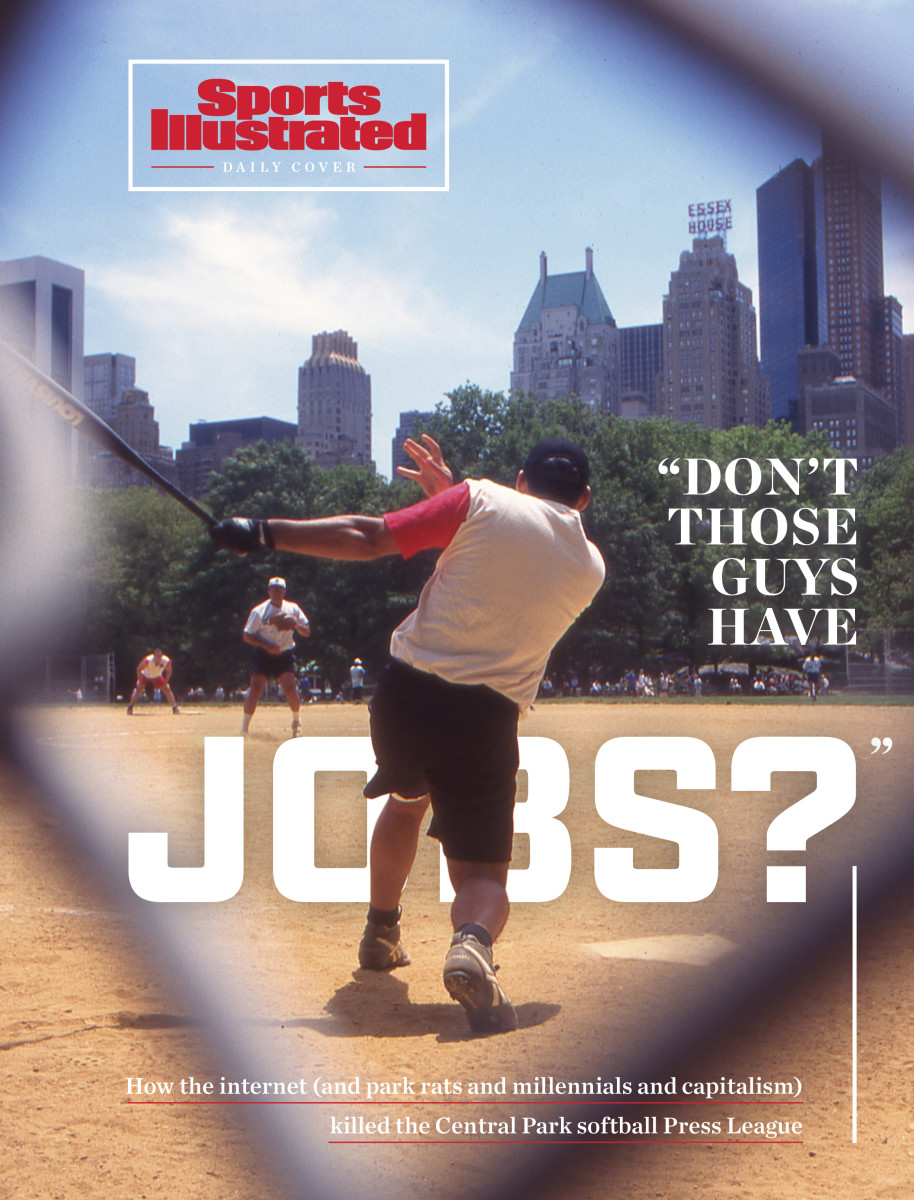
“I’d hear it every year,” says Ben Walker of the Associated Press. “Don’t those guys have jobs?”
Yes. But they never let those jobs impose on their softball careers. Fred Lief, who pitched wire-to-wire in the Press League—which is to say that he played every season between 1976 and 2018 for one of the two wire services, the AP or UPI—says, “There is no other institution in my life, not a job, not my marriage, that endured as long.”
Lief underwent four knee surgeries in his softballing days and, unofficially, was Charlie Browned more times than any hurler in Press League history. He took the mound late into his 60s.
Murray Chass, enshrined in the writers’ wing at Cooperstown, played softball in Central Park from the mid-’60s into his own mid-60s. “The Press League became the highlight of my week,” says Chass, who pitched first for the AP and later for The New York Times. “I did not let anything interfere with a game.”
Not anything. In 2003, Chass had surgery to remove a brain tumor. He was 64. The following spring he returned to the mound sporting a batting helmet.
What follows is an elegy. To a softball league. An industry. A generation.
***
When Fredrick Law Olmsted and Calvert Vaux designed Central Park in the 1850s, ballplaying was considered too niche an interest to deserve its own space. Nevertheless, they eventually reserved an area—five diamonds, with a communal outfield in the middle—for lads to play ball. A 19th-century skateboard park, of sorts. Later, a proviso was added: Only well-behaved school boys, armed with a note from their principal, were granted access to the Heckscher Fields.
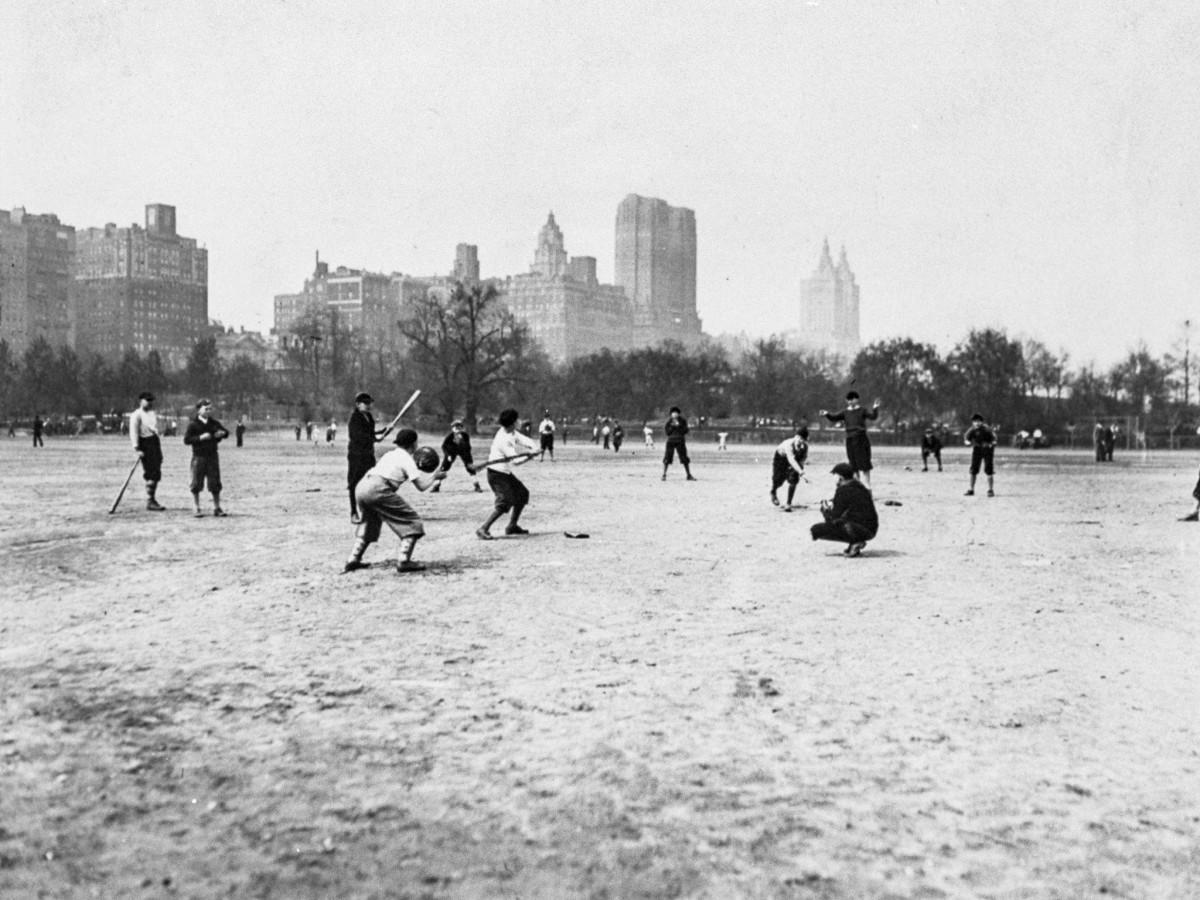
During the Prohibition era, adults took over. In 1955 came the Broadway Show League, with teams representing theatrical productions, media outlets and restaurants. Our story begins 10 years later, in March 1965, with Ray Corio, a senior at City College of New York who was balancing his studies, a potential spot on his school’s baseball team and his job as sports editor at the school newspaper. When The New York Times phoned, offering Corio a gig as an overnight copy boy, he says he “wondered if my playing days were over.”
They were just beginning. That spring, Corio, 21, took part in the Show League’s opening day festivities, in which all the teams took breakfast at Sardi’s, followed by a parade of convertibles up a closed-off Fifth Avenue, into Central Park. There a throng gathered to watch film legend Gloria Swanson (Sunset Boulevard) throw out the ceremonial first pitch. “I thought it was quite a fuss,” says Corio. “I also thought: Why would I ever work anywhere else?”
And so Corio spent the next 40 years of his life working at the Times. And even more years playing softball in Central Park.
The Show League provided New Yorkers the most spectacular blend of the national pastime and the dramatic arts since Damn Yankees—which also debuted in 1955. It also supplied many a future Press Leaguer with a taste of the intensity and absurdity of softball at the Heckscher Fields. Chass, for instance, recalls witnessing Oscar winner George C. Scott going full Patton on an umpire, striking the official with his own mask. Doug Goodman, a stagehand and future Press League regular with Sports Illustrated’s team, remembers gaping as Al Pacino played in an Armani suit and Gucci loafers. (“He’d cheat up in the batter’s box and take these little steps forward during the pitcher’s windup. But who’s going to call out Don Corleone?”) He also remembers winning the league in 1982, when he was the stage manager for Torch Song Trilogy. “[Writer and star] Harvey Fierstein called the team on stage after a performance to take a curtain call,” says Goodman. “Harvey was tickled that the gayest show on Broadway won the softball title.”
Jimmy Colton, who was an 18-year-old AP photo editor when his Show League career began in 1972, remembers one of the most feared boxers on the planet appearing at Heckscher with not two gloves but one. "Roberto Duran would show up with his mitt asking to play," Colton recalls of the former light heavyweight champion of the world. "And no one was going to tell him no, because he was Roberto f-----' Duran."
***
If the late Bobby Henn, a writer at the Daily News, had not cooked up the idea of the New York Press League in 1976, someone else would have. The previous summer this publication had run a cover story headlined THE BASEBALL BOOM. The national pastime—and, by extension, softball—was part of the zeitgeist. Editors waiting for writers to file late-night game stories were playing catch or Wiffle ball in newsrooms. Softball was, to paraphrase a line from Annie Hall, which was filming in Manhattan that summer, “the most fun you can have without laughing.”
So, yes, someone would have thought of it, but give the byline to Henn. “So many of us in the business were playing in more than one Central Park softball league,” says former UPI editor Fred McMane. “Why not have a league for ourselves?”

Six teams—a number that would never change in 43 seasons—played that inaugural year: the AP, UPI, the Daily News, the New York Post and two squads from The New York Times. (The Gray Lady dubbed its squads Times A and Times B, squandering a shot at literary whimsy: Best of Times and Worst of Times.) And the new league had a few wrinkles. Modified fast-pitch (no windmill wind-ups) games went nine innings, not seven. Bases were 65 feet apart, not 60. A 15-game season would be played on Wednesdays at 1 p.m., when the fields were vacant due to Broadway matinees.
That inaugural season, Times A won it all behind a fleet, 32-year-old centerfielder named Ray Corio. The league’s MVP would never again play that well, but he would become the only person to take one at-bat in every season of the league’s existence.
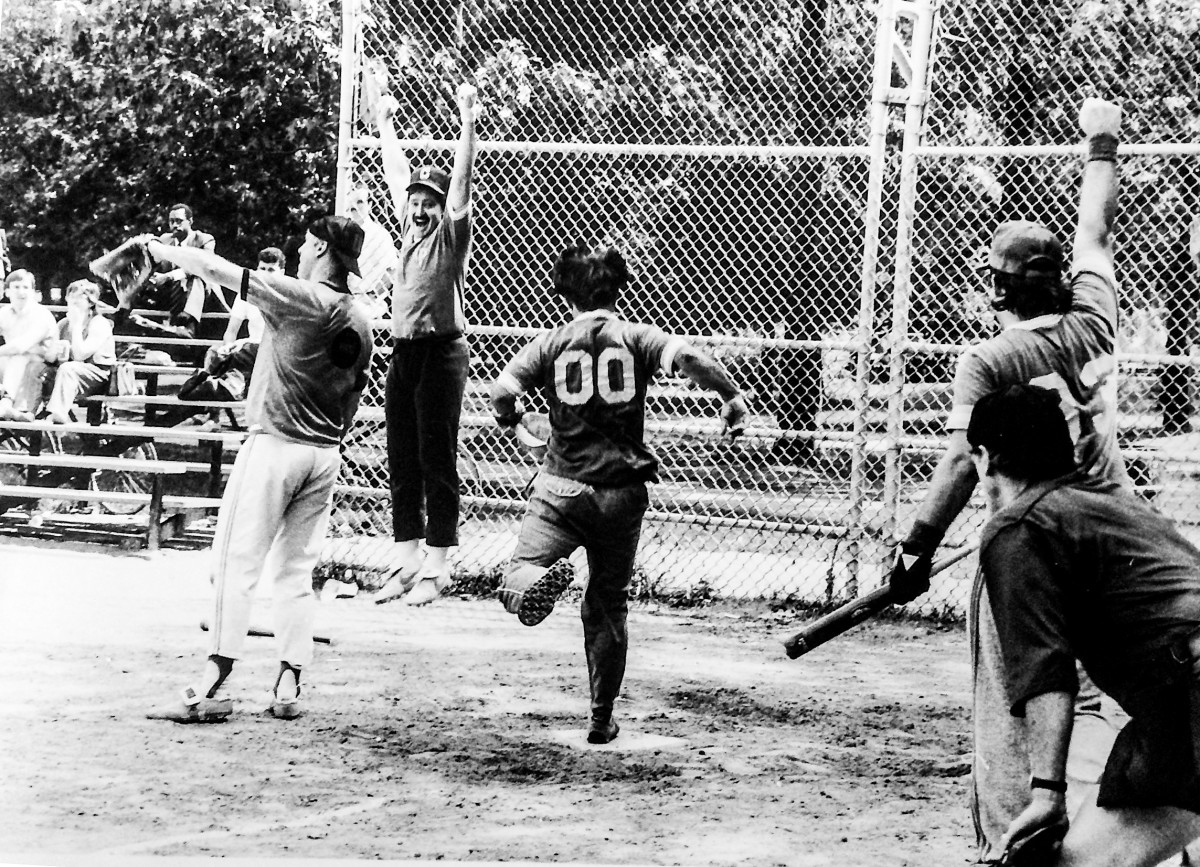
***
“I took over as commissioner in 1978 with the idea that we’d serve two-year terms,” says Fred McMane. “But no one else wanted the job, so I kept it for 15.”
McMane nurtured the fledgling league as if it were his front lawn. A Tuesday-night downpour would incite the Brooklyner to catch an early-morning subway to the Central Park maintenance shed, where he’d gather a broom and rake, grooming the infields himself. Says McMane: “I understood how badly these guys wanted to play.”
And they did. The rivalries in print—between the wire services (AP versus UPI) and the tabloids (the Post versus the Daily News)—reverberated at Heckscher. Press box, batter’s box. “It mattered a lot because we all knew each other,” says Walker, the league’s all-time hits leader. “We wanted to beat each other in the headlines, in our stories and on the field.”
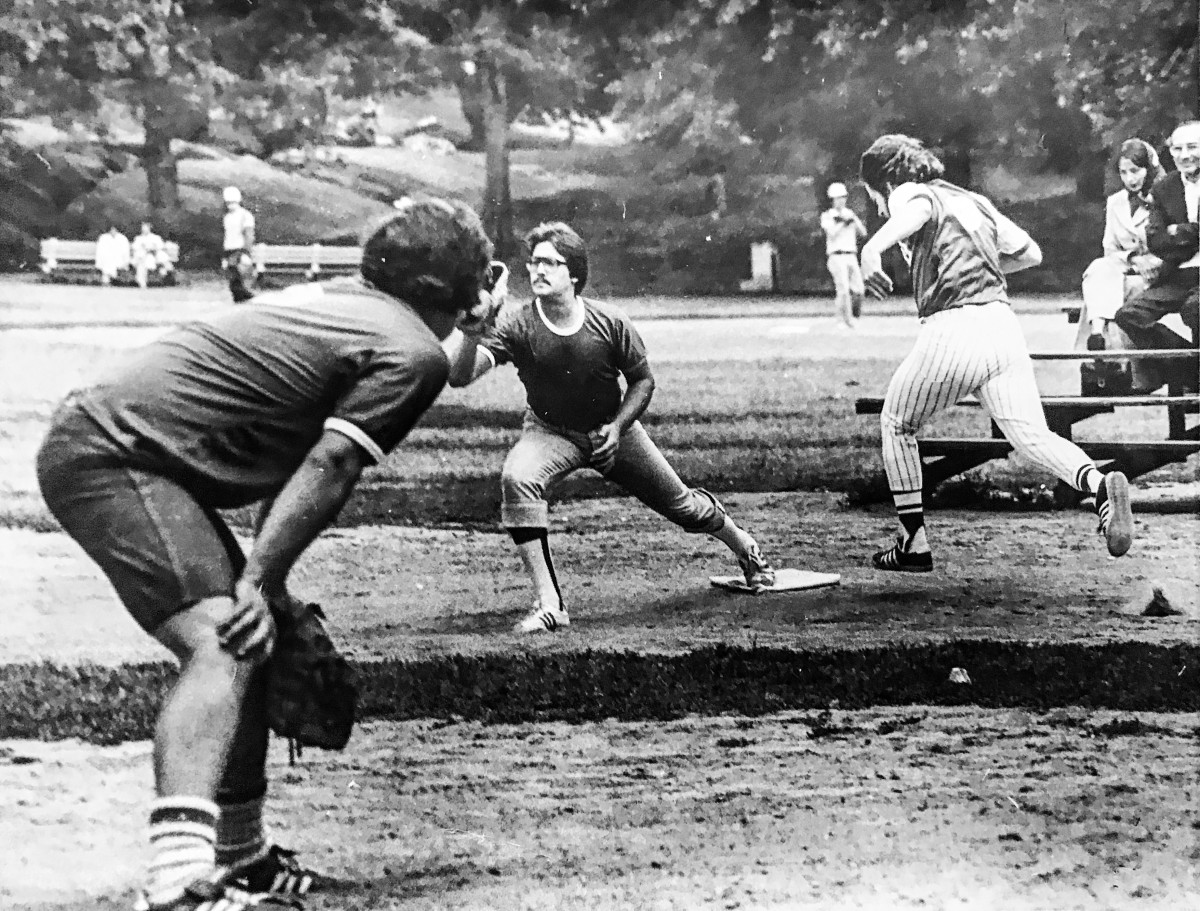
The talent level was uneven—SI reporter Armen Keteyian had played at San Diego State; others had covered the San Diego Padres—but the chatter was consistently redolent of a scene from His Girl Friday. These were print guys, after all, cracking wise. “One year our Times A team had Chuck Fein, Larry Fine and Steve Fine,” Corio says. “I used to say we led the league in fines.”
There were characters aplenty. Eddie Lavin, a lovable lush who pitched for the Post, needed not 12 pitches to loosen up but six Budweisers. And a chaser. “Eddie could barely keep his balance on the rubber,” says umpire Charles Krichman, whom Press Leaguers knew fondly as Butch. “But he absolutely could not pitch sober.”
Bill (Billy Bob) Barnard, a pitcher with a push-broom mustache, typified the passion Press Leaguers brought. In 1992 he flew back from a family vacation in Texas on the morning of the championship game to take the hill, with plans to return the same day. “I feel sorry for whoever sits next to you on that flight,” Walker, his AP teammate, said after Barnard got the W.
“Because I stink?” asked Billy Bob, doused in champagne.
“No, because they’ll have to listen to you talk about the game for three hours.”
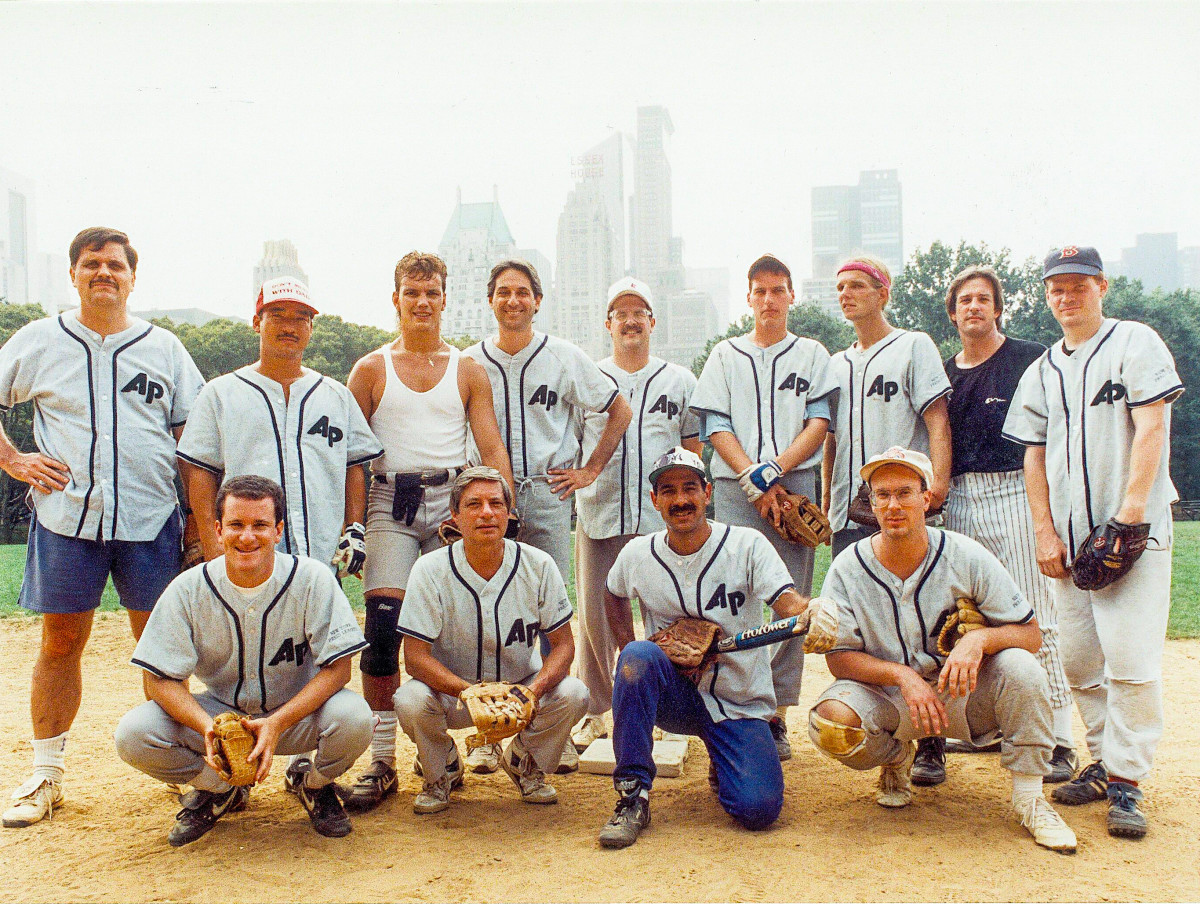
The Press League was a release, a place to get yer ya-ya’s out. Walker and UPI’s Mike Tully, writers who competed against each other on the Yankees beat, could gab about last night’s game or take each other out with a hard slide. Or both. Ambitious SI staffers could, as Keteyian puts it, “forget about climbing over one another up the masthead for a few hours.”
Given that on/off-field interplay, careers could hinge on softball prowess. Jimmy Colton went on to be the photo director at Newsweek into the late ’90s, and he played a flawless left field for the AP. Steve (Down the Line) Fine, who held the same job at SI, was a dead pull hitter. After more than a decade of frustration, Fine hired Colton in ’98 as his deputy chief. “Half the reason Steve hired me,” says Colton, “was to lift his batting average.”
Back in those days, print media, like the national pastime, held a position of primacy. Between the foul lines were familiar bylines: Chass, the Daily News’s Frank Isola, Keteyian at SI. . . . Rosters, like magazines and newspapers themselves, were overstuffed. Ringers—freelancers, as it were—were superfluous. And not welcome. “Absolutely no ringers,” says McMane. “I enforced it.”
With exceptions. Colton, after all, played for the AP while working at Newsweek—“but I had worked for the AP before that, so I was grandfathered in,” he says. His AP teammate Bill Scheft was the emcee at Catch a Rising Star, a comedy club on First and 78th, where he introduced the likes of Jerry Seinfeld and Paul Reiser—but Scheft would find just enough work as an AP stringer to justify a spot in the lineup.
“In the ’80s you could bring in a guy who wasn’t full-time staff,” says Scheft, “but he wasn’t a guy who batted third in seven other leagues.”
That would change.
***
The first thing to know about Charles Francis (Butch) Krichman is that he was kicked out of the Show League for being “too bombastic.” The second thing to know is that he is an umpire. Butch, 70, is likely the most prolific arbiter of balls and strikes in the history of New York City. Only the jewelers on 47th Street have trained eyes on as many diamonds. “I’ve umpired more than 15,000 games in 40 years all over the city,” he says. “In my prime, I’d call six games in one day.”
His renown, though, extends far beyond the Press League. Major league umpires have often been spotted watching—and occasionally playing in—Butch’s Central Park games. A few years ago at spring training in Lakeland, Fla., Joe West, the longest-tenured ump in MLB, spotted the AP’s Walker and asked, “Hey, Ben: How many more games do I need to catch Butch?”
With a thick blond mane—hair “more meticulous than his strike zone,” says longtime SI baseball writer Ben Reiter—and tight blue shorts, Butch was the league’s most arresting sight. One always knew it was him behind the mask because, well, he rarely wore one. “I found that I focused more,” he says.
Even blind people, whom Butch was often accused of being among, could recognize him. Because he was always on blast. “That voice!” laments one former player. “They should put Butch on buoys in New York Harbor. You could never find another voice like that—even if you went to New Jersey.”
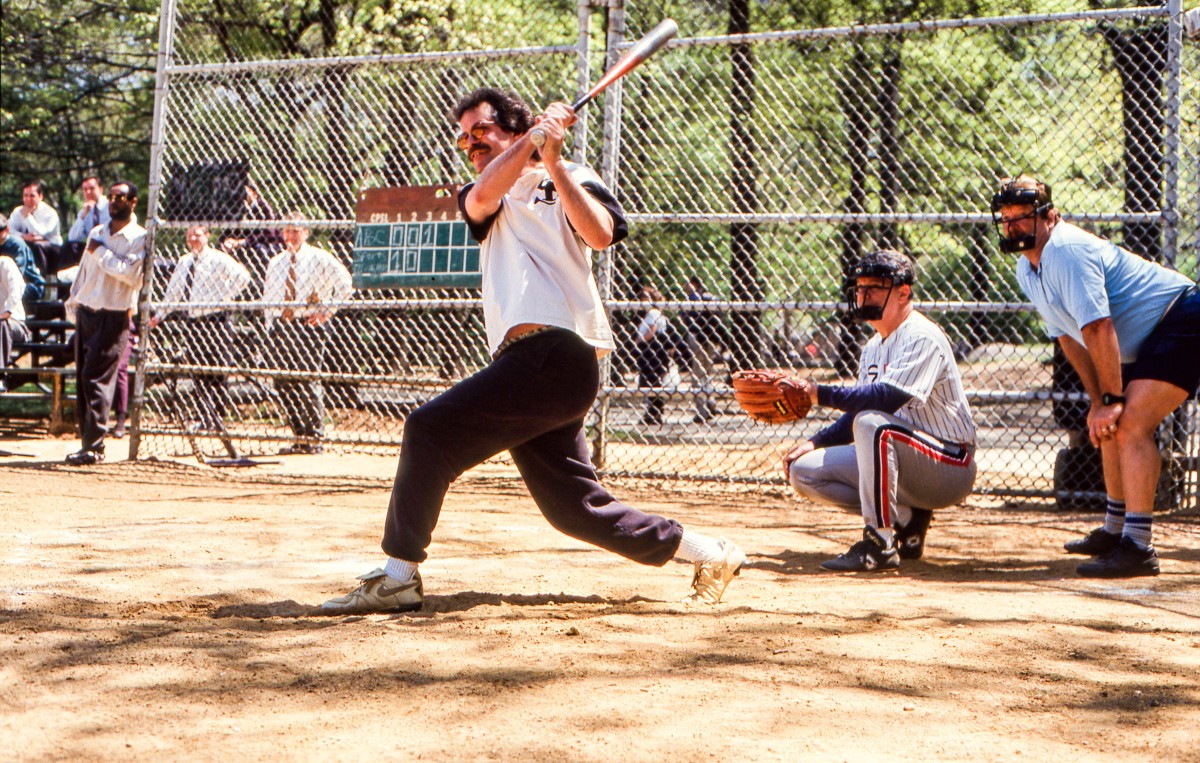
The scouting report on Butch (who was raised on the Jersey shore, by the way): He wasn’t always right, but he was always sure. “Butch wasn’t the most accurate umpire,” says Goodman. “But he was always in control of the game”—and, with another game or two on a given day’s schedule, in control of its pace.
“I hit a line drive to right field and got thrown out at first,” says Scheft, the eventual Late Show head writer who played for the AP. “I hung my head as I walked back to the dugout. ‘Butch, what happened?’ I asked.
“ ‘Well, you really tagged that ball, and the fielder made an alert play,’ he said. Then he confessed: ‘I moved the bases back 10 feet cuz I can’t have the game take too long.’ ”
Sometimes Butch was both sure and right. In 2015, Keteyian, who played in the Press League into the 1980s, stopped by Heckscher for the first time in 25 years. At least. As Keteyian, whose decorated career has included stops at HBO Sports, 60 Minutes and The New York Times’ best-seller list, approached the field, he heard his name. “Armen!”
“Butch?”
Pointing at Keteyian as if preparing to toss him, Butch declared to no one in particular, though it was probably heard in Bay Ridge: “Best shortstop in the history of the league!”
Well, s---, Butch.
Too bombastic. For the Broadway Show League. And yet, how many thespians get a scene with Robert De Niro, opposite whom Butch appeared in the 2008 film Righteous Kill? “I play an umpire who tosses [De Niro],” he says. “One line, two words: ‘You’re gone!’ ” The conceit is that the ump, named Butch, gets the call wrong.
“Butch,” says one old-timer, “was just playing himself.”
***
In 1989, ABC’s New York affiliate hired as its weatherman Bill Evans, a former walk-on at Mississippi State who evolved quickly into both a popular local personality and a “park rat,” someone who only plays softball when he’s awake. “I’d be in the studio, minutes away from doing a hit on Good Morning, America and taking practice swings,” says Evans. When he learned about the Press League, he was giddy. “They have softball at 1 p.m. on Wednesday afternoon? Holy crap, I’m in!”
But there were no vacancies. When, finally, The National, a sports-only daily that had fielded a squad, folded after one year, Evans contacted McMane, the commissioner, and told him ABC could get enough guys. Thus, ABC joined the Press League in 1991. Three years later, Evans was named commish.
Sunny and warm, Evans is, but with a chance of thunderstorms, as Press Leaguers discovered. He instituted an All-Star Game, complete with home-run derby, skills competition and professionally-performed national anthem. He also brought a camera crew one year to a championship game between ABC and The New York Times.
“‘They’re going to shoot the game!?!’ ” was the reaction of Brad Smith, who was then working at the Times (and also played at SI). “We were Michael Jordan–livid. That was all we needed. We went out and crushed them.”
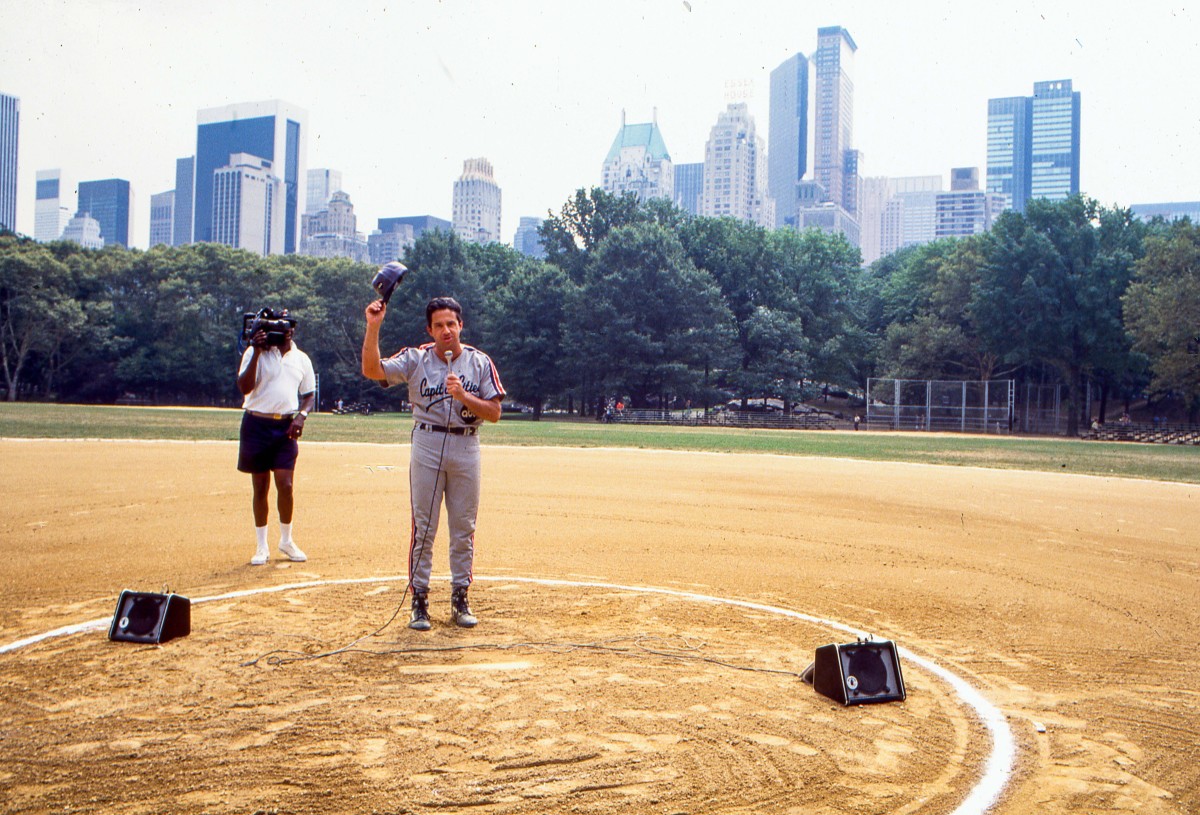
Evans’s most impactful—some would say devastating—innovation was to open up the league to ringers. Under him, the Press League became park-rat-infested. And few if any teams welcomed more vermin onto its roster than ABC, of whom it was often said: You only have to be able to spell them to play for them. “[Evans’s] Xerox repairman was his pitcher,” moans Goodman, who by the early 1990s was managing a stand-alone SI club.
Bill Henry worked in sales at ABC. He had also pitched for the Yankees in 1966. Henry played for ABC. But at least he had a valid employee ID. “Evans would have seven stagehands on his roster—or at least that’s what he called them,” says Chris Lentine, a longtime player-manager for the Times. (Lentine himself has worked at SportsTicker and MLB.com, but never at the Times. That’s beside the point, though . . . isn’t it?)
This was in the mid-’90s. Across sports media, choices were being made at the top echelon that were expedient in the moment but that would incite seismic change. SI, itself, had already passed on an offer to buy ESPN in 1987. (Strike one.) Now it and other publications were wondering how to deal with this double-ya double-ya double-ya nuisance. In conference rooms, editors asked: Do we put up a pay wall and lose readers? Or post content for free and lose revenue? Along the Heckscher sidelines players argued, Do we only play staffers and lose games? Or do we recruit ringers, too, and sacrifice our identity?
In 1995, when SI won the Press League, the clean-up hitter was a 6' 2" slugger named Fran Fitzgerald, who worked at People (a sister publication) but had also spent three seasons in the Orioles’ organization. A ringer.
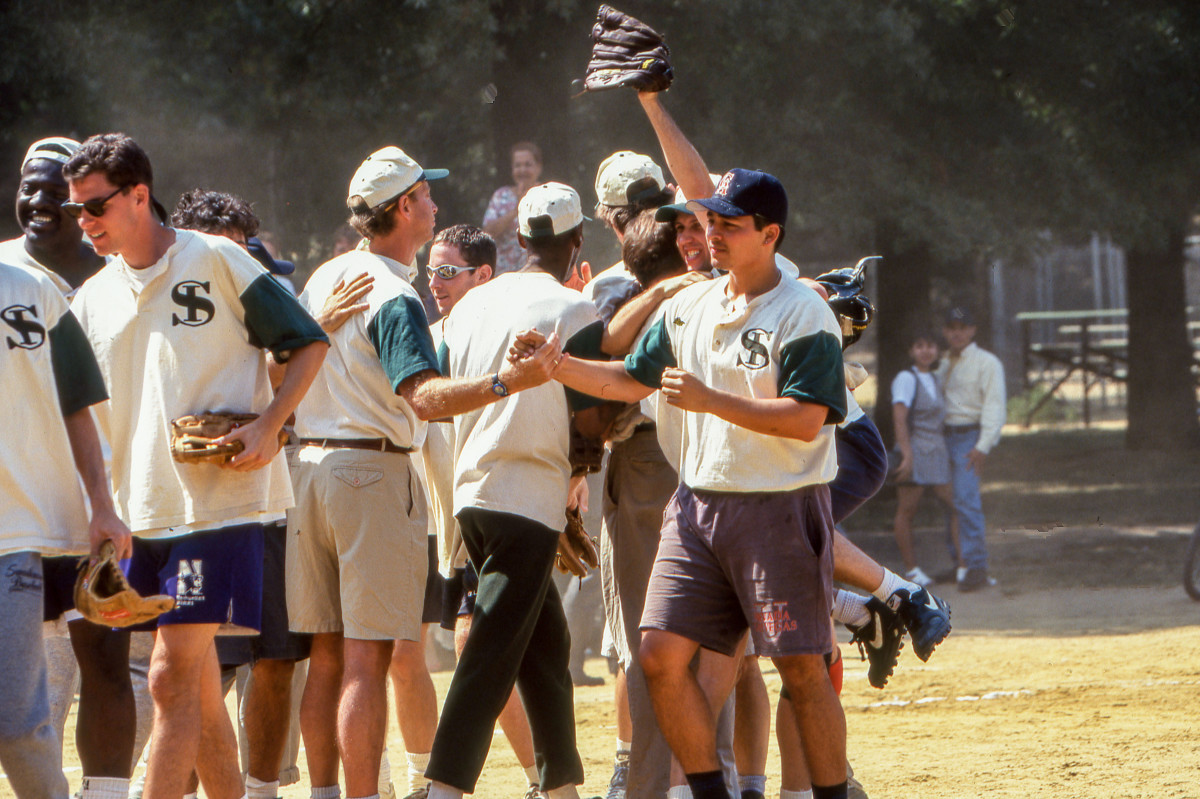
“Field 4 had a tree that straddled the left field line,” recalls Steve Fine, a teammate. “If you hit the tree on the fly it was a double. Fitzgerald hit it over the f------ tree.”
Everyone was juicing their lineup. Walker, at the AP, noticed a late-night janitor named Mike who seemed to pick up trash bins with an instinctive athletic grace. He conferred with Billy Bob, and they put Mike in the lineup. “Mike’s so fast,” Barnard and Walker assured each other, “if he just puts the ball on the ground, it’s a base hit.” Sure enough, Mike hit a two-hopper in his first at-bat—and sprinted hard left, from home to third.
As commissioner, Evans enforced McMane’s old ringer rule about as vigilantly as Central Park’s mounted police enforce marijuana laws—which is to say he didn’t. Still, he’s only the weatherman. He didn’t make the rain. Al Gore, or whoever invented the internet, was just as much at fault.
“Wednesdays were always our days off at SI,” says Goodman, who worked in the magazine’s news bureau for 18 years. “But who has time off in sports with the internet? Everyone had more work to do.”
And soon there would be fewer people to do it. Evans stepped down as commissioner in 2002, but he continued playing until ’10. What forced his retirement? “I had to do internet hits for our ABC-7 website weekdays at 1 p.m.” he says. “The internet killed the Press League.”
***
Crafty and cantankerous. Adroit and agitated. Murray Chass spent decades antagonizing batters with a dyspeptic mound presence and a deceptively effective arsenal of pitches.
If you’ve ever seen Joe Cocker perform, then you’ve seen Murray Chass pitch. He’d growl and strut and motion to his catcher. Then he’d stare plateward, looking angrier than a guy who’d asked for a schmear and gotten butter. (Who does that?!) Finally, he’d hurl the slowest pitch you’ll ever see outside of T-ball.
“He was the epitome of a crafty lefty,” says Walker, who faced Chass for nearly a quarter-century. “Murray would beat your team 5–2 and all your guys would be like, ‘Man, I can’t wait to hit against him again—I just missed.’ Five weeks later, that same hitter would go 0-for-4 with three routine fly balls.”
“Hitters fooled themselves,” says Chass, 81. “I didn’t have a knuckleball. I didn’t have a fastball. I didn’t have a curve. I always had great control. I could hit the corners.”
Mention Murray Chass—pronounced like pass—to a former Press Leaguer and the immediate response is either 1) he struck me out three times or 2) I took that [expletive] deep! Nobody forgets facing Murray Chass.
“Oh, Murray was a rooster out there,” says Keteyian. “A bantam rooster.”
It may have been possible to strike out swinging on Murray’s first pitch alone, so lethargically did it trace the 60 feet, 6 inches. Most, however, went out with the bat on their shoulders. “They’d let a pitch go by that they didn’t like, ‘strike one,’” Chass recalls. “They figured they’d get the next one. Next thing you know they’re headed back to the dugout.”
“Murray was a demanding battery mate,” says ESPN’s Jeremy Schaap, who spent a summer interning at the Times, catching and kvetching. “In our first game together, maybe the first batter, he kept motioning me to set up closer to the plate. I obeyed. Despite the lack of protective gear. I’m practically sitting on the plate. Murray pitches, induces a lazy fly ball. Butch gestures in a way unfamiliar to me, like he’s wiping dirt from his shirt and points to first base: catcher’s interference. It went downhill from there.”
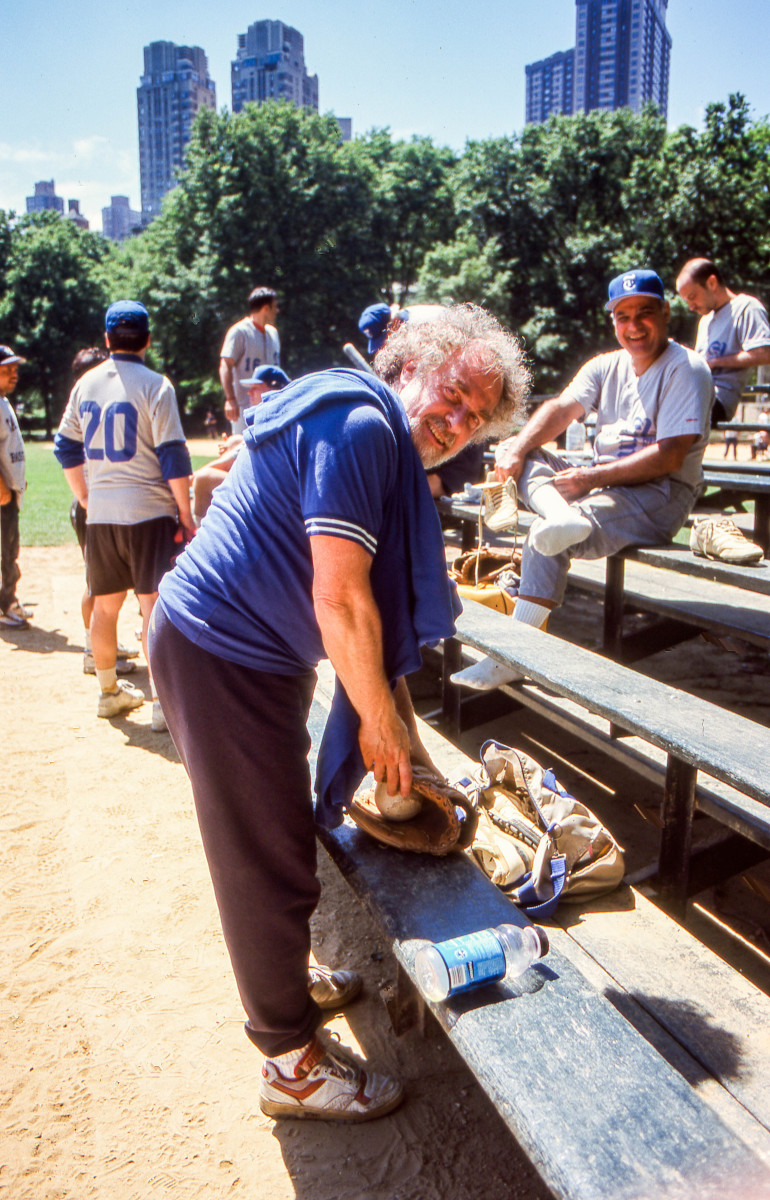
Ben Walker is as agreeable a sort as anyone you’ll find from the Press League, so this story is illuminating. “I had a talent for placing the ball where I liked,” he says. “One time against Murray I just decided I’m going to hit it up the middle. I hit him in the knee with a line drive, knocked him out of the game. Murray had to go to the hospital. I remember thinking: I should feel worse about it.”
Capable of rankling everyone from George Steinbrenner to Ben Walker, Chass was nevertheless respected universally as a reporter and a player. And yet almost nobody knew that Chass, who on gamedays commuted into the city from Paramus, N.J., considered pitching his second-greatest talent.
“I was equally proud of my ability to get a parking space [around congested Central Park] as I was my pitching,” says Chass. “Many a time I’d come home and talk about the parking spot before talking about the game.”
That is a true New Yorker.
***
In July 2003, Bill Scheft published his second attempt at a novel, the protagonist of which was a Central Park softball junkie. Word about The Ringer spread from the Heckscher Fields north to the Great Lawn, and soon Scheft began attracting park rats as if he were a discarded pizza slice. Says Scheft: “I can’t tell you how many guys approached me and said, ‘I heard you wrote a book about me.’ ”
Guys like Mike Peckins. For 19 years now Peckins, 46, has been a boy of summer, an unpaid professional softballer who happens to earn a living serving tables at Raoul's, a trendy SoHo bistro. What’s impressive about Peckins is not just that he has played at least 100 games in and around Central Park every year since he was 21; it’s that he went 25 years, he says, without missing one . . . until unforeseen circumstances—something about a quick getaway to Miami with his girl, food poisoning and a missed flight—ended the streak.
Peckins is an outstanding softball player. To survive 19 years at Raoul’s, he must be an excellent server. “I’m good at everything I do,” he says matter-of-factly. But while Peckins has operated a French press, he has never worked in the press. The publishing logos he wore across his various Press League jerseys? Misleading headline, an editor would say.
One of Peckins’s teammates when he played with the Times was Mailon Kent. If the name sounds familiar, his father (and namesake) came off the bench in the 1963 Iron Bowl and outdueled Joe Namath, leading Auburn to a 10-8 win. The younger Kent inscribed his own legacy in Tiger lore: He broke Bo Jackson’s career base-stealing record.
When Peckins calls Mailon Kent “the best player in Central Park,” it’s an assertion no one disputes—and that includes John Rodriguez, who made an appearance or two with the Times and had a couple at-bats in the 2006 World Series with the Cardinals. “The best part,” says Peckins, “is that [Mailon] doesn’t care.”
Kent is a park rat, but a sanguine one. “I’ve attended numerous Auburn-Alabama games,” says the three-time All-SEC centerfielder. “I played in softball leagues in Birmingham before I moved to New York. The Press League, their games meant so much more to them than I thought softball should ever mean to anybody.”
Lentine hired Kent at MLB.com explicitly to play softball for the Times. That is not an accusation; it’s a fact that both readily share. “When I saw his baseball résumé,” recalls Lentine, “I said, ‘We gotta hire this guy.’ ”
The Press League of Central Park was park-rat-infested, often with players known only by their aliases. “Catcher Joe” was a doorman on the Upper West Side (and Eddie Lavin’s personal backstop). So was “Sugar,” who played on every team in the league.
Back, though, to Mike Peckins. The year was 2009 and CBS, with Peckins ringing at shortstop, lost the championship game to the Times. “Guys have tears running down their faces, and I’m gathering us together on the infield,” Peckins recalls. “I’m assuring them that we’re going to stay together, that we’re going to come back next summer better than ever.”
It was then that Bobby Burrous, CBS’s manager—an actual employee of the network—informed the team that only staffers would be welcome the following year. At which point Peckins unleashed hell. “I cursed him out,” he says.
Lentine, still celebrating with his Times teammates, noticed the ruckus. He strode across the diamond and invited Peckins then and there to join his team the next season, promising he could pitch and bat first. “Chris offered me a really nice package with the Times,” Peckins says.
Are we still talking about softball?
“Yeah,” says Peckins, who along with Kent made the Times the league’s dominant ballclub in its final decade. “Listen, I’m a ballplayer. It’s all I ever wanted to be. And I got to play the game in the heart of New York City every summer as much as any guy in pinstripes.”
Keep in mind, almost every player in this story is or has been a ringer. Remember the Damn Yankees tune “You Gotta Have Heart”? Well, in Central Park you gotta have Rat. “If your team is made up entirely of guys who work at your place and only play once a week,” says Lentine, who should be in the Mets’ front office, “you’re going to go 2–13.”
Brad Smith, who actually did work at the Times when he played for them, remembers an altercation with a tall, fair-skinned first baseman in a Celtics jersey. “When I returned to the bench, one of my teammates said, ‘You don’t wanna mess with Jimmy.’ ”
“ ‘Why not?’ ”
“ ‘He’s a member of the Westies [a notorious Irish gang based in Hell’s Kitchen],’ I was told.”
Smith mulled that information for a moment. Then he asked, “What is an Irish mobster doing in the Press League?”
Batting cleanup and playing first base.
***
If New York City is the epicenter of North America—O.K., the universe—then Times Square is the epicenter of New York City. And there, just a half-mile north of that oft-toxic maelstrom of humanity and commercialism, and not in some cornfield in Iowa, lie ball fields.
“I’m from California, and at first it was overwhelming [playing there],” says ESPN’s Paul Gutierrez, a rocket-armed outfielder for SI in the late ’90s. “Over time, just like the city itself, you begin to appreciate it. Stop fighting it. I’m playing softball in Central Park, just like Oscar Madison.”
Says ABC’s Evans, attempting to put into words the sensual allure of the Heckscher Fields: “Everyone in their psyche has a green patch of grass. It’s ingrained.”
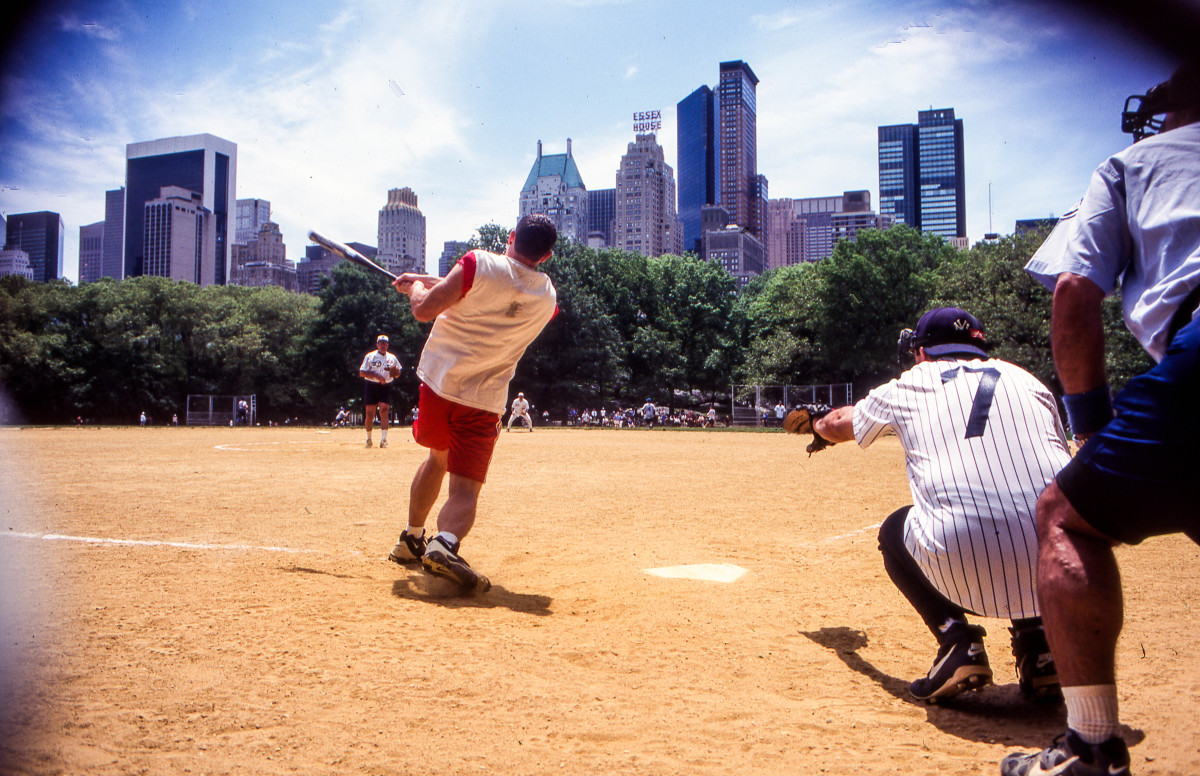
Yes, everyone has a green patch of grass. But Heckscher’s unique layout meant that you were time-sharing it. “If I was playing right field on Field 5,” says Fine, “then I was facing the left fielder from the game on Field 4, who was standing a few feet in front of me.”
To anyone who has waited for the downtown 6 train at 86th Street on a Monday morning, such proximity is no big deal. In fact, it has upside. “I spent so much time standing a few feet away from [the Times’s] Charlie LeDuff in the outfield,” says Kelvin Bias, who played 15-odd years for SI, “that we became good friends.”
Still, there were challenges. Outfielders feared collisions—Colton broke his jaw in such a mishap—but feared a moon shot hit by Fran Fitzgerald or Mailon Kent more. “If the ball got past you,” says Gutierrez, “there’s a chance it’s rolling into the infield of another game.”
No outfielder wanted to hear Butch’s authoritative “Time!” while sheepishly retrieving a four-bagger from another diamond. Or to feel the baleful stares from two other teams. Of course, Heckscher’s unique layout also afforded opportunity for glory.
In the summer of 1992, as the story goes, a sky-high pop fly disappeared into the branches of the Field 4 tree, but SI outfielder Tim Crothers continued to give chase. Eventually the ball landed in the mitt of Crothers who, on a dead sprint, swerved to avoid MTV’s Jenny McCarthy, in the midst of a photo shoot. “I don’t remember that,” says Crothers. (Others do.) “I do remember that year [covering] a fight in Atlantic City and being seated next to Donald Trump, who invited me to ‘Check out my wife’s ass.’ ”
Foreign tourists would make pit stops and watch in fascination. As would office-workers out for lunch. “They were into it because we were into it,” says Keteyian, referring to bleachers that occasionally sat celebrities, many of whom lived along Central Park West or Central Park South. Maria Shriver. Liam Neeson. “I’m looking into the stands one day,” recalls Evans, commissioner for eight years, “and I’m like, ‘Is that Hal Holbrook?’ ”
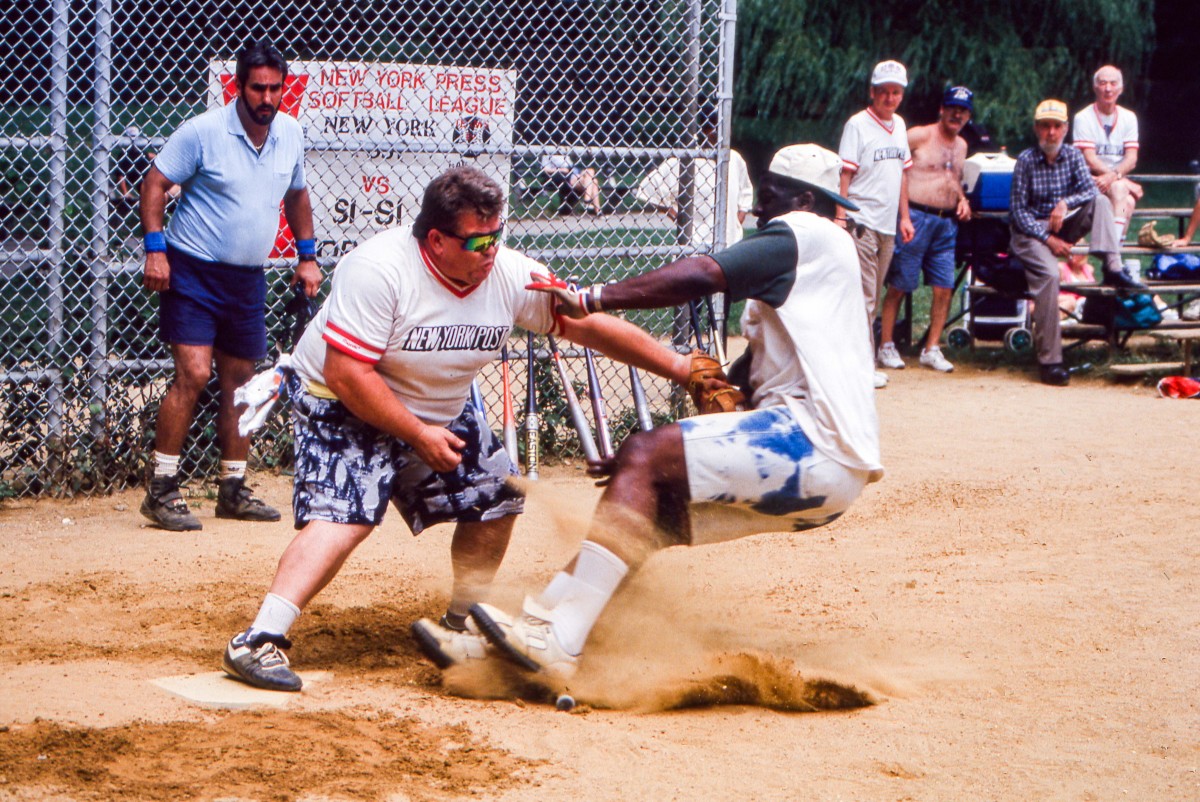
Refreshments were readily available, often via a network of player-friendly Park dwellers—i.e. permanent residents—who for $1 furnished ice-cold beverages of unknown provenance. (“I don’t believe they had a distributor,” chirps Fine.)
When one particularly popular vendor, Smoky, passed away in 2008, the league held a moment of silence. Out of respect, yes, but also out of a grudging acknowledgement. There may be no clock in softball, Butch notwithstanding, but nothing lasts forever. Not even the Press League. Or its players.
“We never wanted to give up our youth,” says Fine. “We never wanted to grow old.”
Invariably, being a baseball writer among peers, Walker would find himself warming up before a game, talking about the latest superstar to hold out for more money. And invariably he would listen as some colleague griped about that player’s tenuous grasp on reality. “He’d say, ‘If I were that guy, I’d play the game for free.’ ”
Pal, Walker would think, you are playing for free.
***
One winter in the early 2000s, Goodman, by then SI’s news bureau chief and softball manager (hardly in that order), spoke with a Press League umpire whose ranks were upset that they had yet to be paid for that summer’s work. This was a Bill Evans matter. Goodman, poking the bear, suggested they phone “7 On Your Side,” ABC’s consumer investigative unit, and report the problem. Which they did, and the umpires were soon paid. Goodman later became commissioner.
“Doug is always right, and Doug is always sure,” says Fine, one of Goodman’s oldest and closest friends. That’s not a dig, it’s a statement of fact, as befits someone who lasted five days on Jeopardy! in his early 20s. Goodman is the type who believes in playing by the rules but also in knowing all of them, the better to creatively manipulate them.
“When Doug played catcher, he never directly questioned a ball or strike,” says Butch. “He’d tell the pitcher so that I could hear, ‘I thought you had that one.’ Smart.”
Teddy Greenstein, long ago an SI reporter and now a Chicago Tribune writer, remembers that when SI won its first championship, in 1995, “Doug installed me as a fifth infielder. Nobody was doing this yet. Everyone else played four outfielders.”
A 5-3 defense, says Goodman. “That’s the year SI had its March boondoggle in Orlando,” four days at the Magic Kingdom. “We held our own spring training that week and I really believe it made the difference in our winning the championship.”
“Doug breaking his wrist in May was the difference in our winning the championship,” quips Gutierrez. “After that he could only manage. Which is what he was best at,” leading the guys. And in the Press League the players were almost all guys, with rare exception.
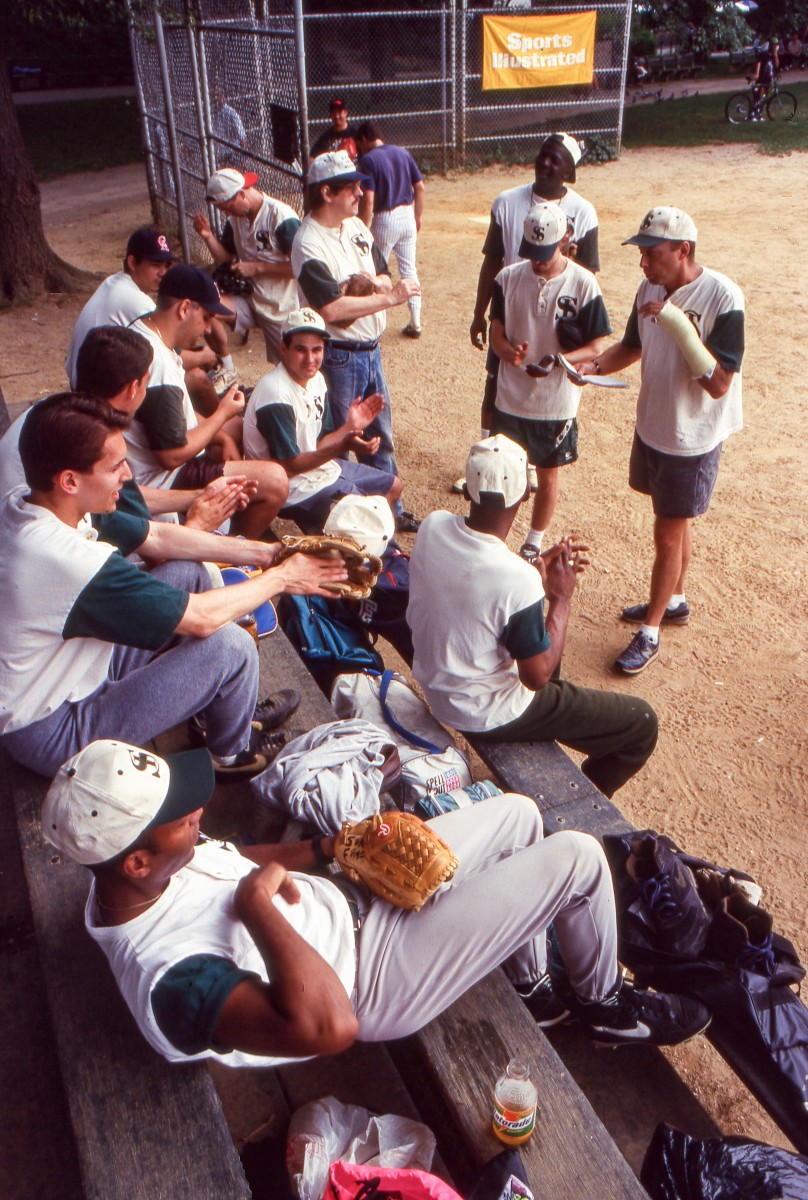
One exceptional exception: the AP’s Susie Misner, who was a ringer as well as a Broadway dancer. A regular in the Wednesday-morning women’s league at Heckscher, Misner also appeared in the Oscar-winning 2002 film Chicago. If you recall the number “Cell Block Tango,” Misner plays Pop. Fitting, as she caught pop flies as the AP’s occasional left-center fielder in 2009.
Arguably the best woman to take the field at Heckscher, though, was LeAnn Wilcox, an editor at the Times who in 1976 had become the first women’s basketball player to get a full ride at Kansas State. Her Manhattan-to-Manhattan odyssey included a season or two playing middle infield for the Times in the early ’80s. “LeAnn had a terrific glove,” recalls Ray Corio. “She once turned four double plays in a single game. It should have been five, but the ump blew the call at first.”
Possibly the briefest performance, male or female, in the Press League belongs to SI’s current national baseball reporter, Stephanie Apstein, who for the last eight years of the league’s existence was SI’s most ardent fan and its scorekeeper with a light touch. “I never assumed the error,” Apstein says.
On a summer afternoon in 2012, with a number of SI regulars in London for the Olympics, Apstein was coaxed out of her pencil and into a catcher’s crouch. “They had me play two innings, but I was so bad that I couldn’t even throw the ball back to the pitcher,” Apstein recalls. “Butch had to throw it for me.
“After that I never wore sneakers to a game again. Only sandals.”
***
Bill Barnard, beloved teammate and ace reporter for the AP, was also a tempest in a T-shirt. He led the Press League in demolished trash cans. On May 12, 2004, SI opened up a can on Billy Bob and the AP, and in the midst of a barrage of runs Goodman golfed a line drive over the right fielder’s head, circling the bases. “Billy stormed off, cursing the team,” Goodman recalls, “and me in particular.” (Quips one longtime rival manager: “If Doug Goodman took me deep, I’d storm off too.”)
The inning wasn’t even over, but Billy Bob’s career was. Three days later he died of a heart attack. Barnard, 52, was buried in a softball jersey.
If the death of Billy Bob was not precisely the day the music died, it was a harbinger. By the mid-2000s, the ringers ruled. In ’06, Peter King, by far SI’s most popular writer, went out for the company softball team. “Everyone’s telling me, ‘Come play, come play,’ ” says King, who’d captained his high school baseball team. “ ‘It’ll be fun.’ ”
It wasn’t. When King, who’d worked at the magazine since 1989, showed up he encountered a bunch of faces he didn’t recognize. Most were not SI employees. Some, like starting shortstop Stephen Skalocky, who played his first Press League game before he even stepped into SI’s office, were interns. (Skalocky, now the mag’s creative director, would acquit himself well on and off the field.)
After five or six games, King, who mostly sat the bench, abruptly retired. “I get it,” he says. “It’s not like I was some 18 year-old American Legion all-state baseball player— which, by the way, I had been. I just thought it was bulls---.” And that’s one thing about the Press League that King thinks he thinks.
The New York Times won eight of the final 12 championships (by then using only one team). That run included an undefeated season in 2013 and a 30-game win streak. Almost none of those players had ever worked for The New York Times. It’s questionable that any of them had ever read The New York Times.
“By the final championship, we had at most three Times staffers on our team,” says Lentine, ringer-manager-commissioner from 2011 until the league ended. By then someone from the newspaper had suggested that Lentine and his teammates no longer play under the Times banner—fake news, yada yada—so they redubbed themselves the New York Softball Club.
SI eliminated Doug Goodman’s news bureau in 2007, and his job with it. “They told me the internet had made the department unnecessary, and I can’t disagree with them,” says Goodman, who continued to play another eight seasons for SI.
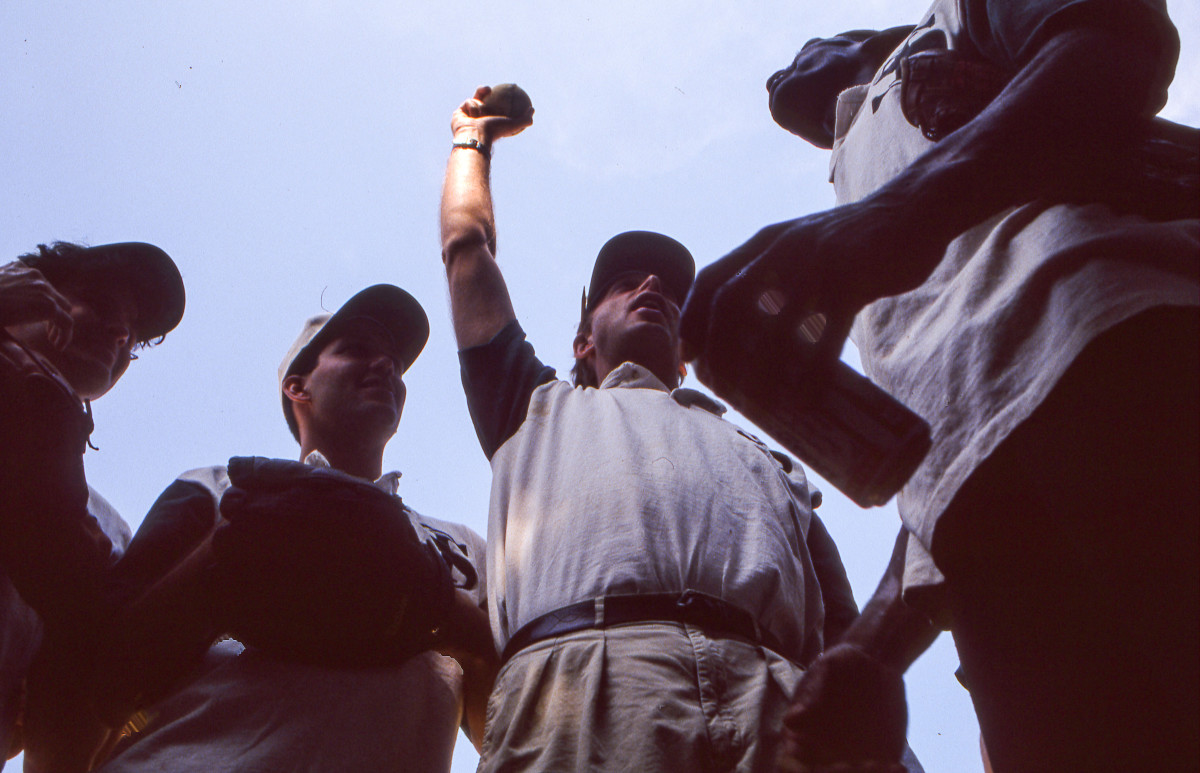
Steve Fine was a casualty of layoffs in 2013—SI “dropped the hammer," he says, "as I was stepping into a cab to head to the Super Bowl”—but he, too, played on for years. Eventually, as rosters shrank due to staff cutbacks or internet responsibilities, Fine turned to his teenage daughter for recruiting help. “Any of your friends interested in playing softball?” he asked—which is how three members of the Beacon School’s baseball team suited up for SI. “We were so desperate to keep this going,” says Fine, sounding like an editor who’d put unpaid bloggers on his site simply to satisfy content needs. “This was our lives.”
The internet killed the Press League, some say. And sure, it’s tough to get away for two hours on a Wednesday if it means a Woj bomb is going to derail your career. Besides, it’s hard enough to play third base without also having to constantly refresh your Twitter feed.
Others blame—wait for it—millennials. “They’d rather hit home runs with their thumbs than their arms,” says Walker. Lief, his AP teammate, puts it more sagaciously: “The internet has turned us all indoors, none more so than our youth.”
That may be true. But millennials did not create “the business model.” They didn’t dine out on corporate cards while deciding to pivot to video. If you put the internet and millennials on your suspect list, make room, too, for mergers and acquisitions, naked avarice and editors who haven’t enough faith that you, the reader, will get this far.
In a final twist of irony, in 2014 the few graybeards who still worked in print and played in the Press League noticed a pronounced uptick of foreign journalists in press boxes. A team was formed—yes, the Press League began off-shoring labor—and thus the League of Nations became the final new franchise.
“We were a mess,” says manager Daisuke Sugiura, who oversaw players from four continents. “We went 2-13 the first season, but I still remember we were accused of cheating—of bringing better players for the playoffs. . . . Hired guns for a softball playoff win at the Central Park? Come on, now.”
By the spring of 2018, Fred Lief, then 67, says it was all “just too depressing, knowing we’d have to pull a few people from the stands just to have enough to play.” He would wake up on Wednesdays hoping for rain.
And that spring and summer, it did just that. Six Wednesdays were rained out. (The curse of Bill Evans?) Lief remembers his final Press League game, on June 6, 2018: “I was pitching, and a hard one-hopper was hit to the mound. I was able to glove the ball, but the force drove me back and I felt a sharp, popping pain in my right leg. The ball fell from my glove as I tumbled backward, knocked down. I scrambled, sprawled on the ground. Face down in the dirt, I reached for the ball and made a shuffling throw to first … getting the runner. I was stretched out for minutes, moaning. A couple guys had to carry me off.”
That July, Ray Corio, 74, took his one and only at-bat of the season, keeping his streak alive. By this time he was mostly coaching bases and keeping score, but Lentine, possibly reading the bold font on the screen, recognized the historic importance of Corio’s plate appearance.
One month later the Press League, deluged both by apathy and rainouts, suspended the season. Within a few days, Corio suffered a massive cardiac arrest. Technically, he died. “The first responders told me my heart stopped for about 90 seconds,” says Corio, who was resuscitated by defibrillator.
The Press League has not returned. Ray Corio came back from the dead. Will the Press League?
“No,” says Lentine emphatically. “Who’s going to play? Nobody’s going to play any more.”
Don’t those guys have jobs?
They used to.
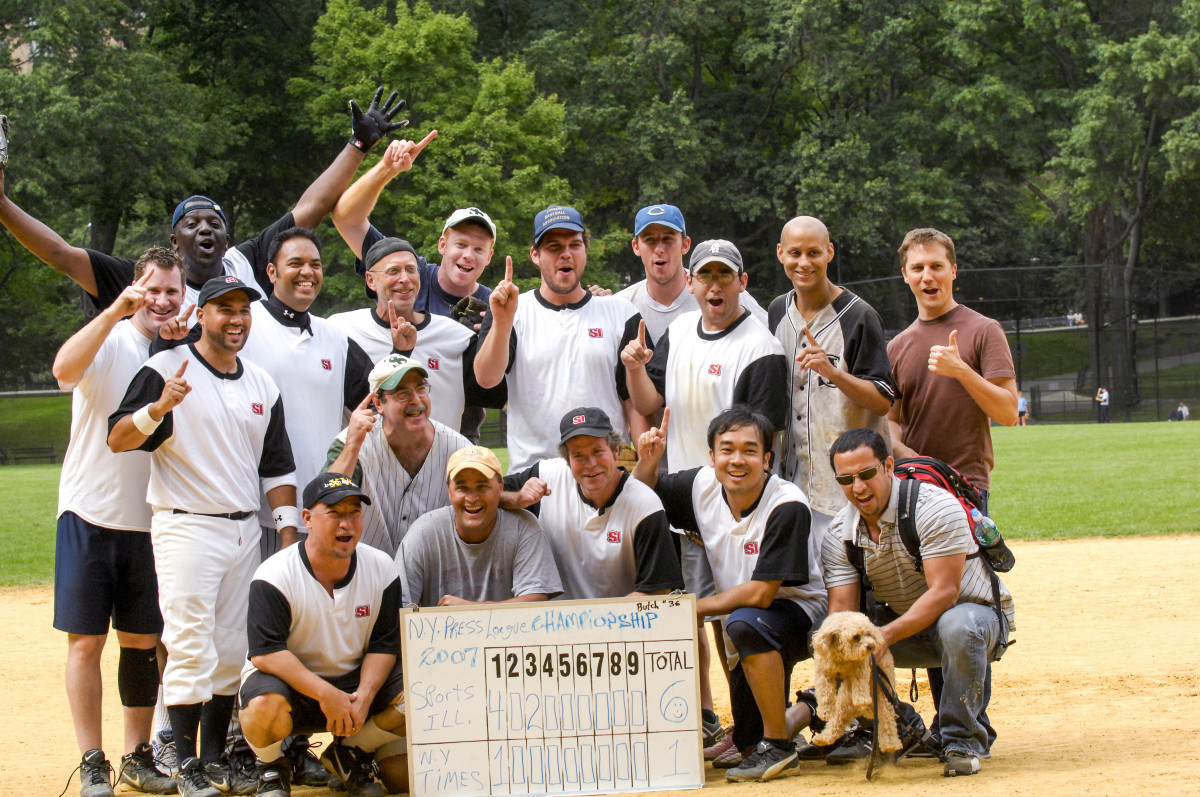
John Walters covered college football and media for years as an SI writer. If he missed your Press League story, he's happy to hear it; email him at trumansparks88@gmail.com.
